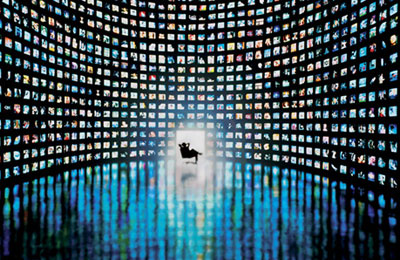
Media summit focuses on multi-screens
Abu Dhabi, October 24, 2013
The rise of multi-screens and how the advent of the second and third screen is augmenting and changing the TV industry were the subject of back-to-back panels at the Abu Dhabi Media Summit.
Samantha Barry, social media producer for BBC World News talked about the impact second screens were having on TV news and viewing.
“Engaging with your audience is what is key to second screen news, it’s about interacting,” she said.
“Using second screens, viewers want a whole different voice – tone and content we make for second and third screen TV is very different to what we broadcast on TV. The tone and using a personal voice is really important.”
Eric Kuhn, head of digital, United Talent Agency, said that talent often tweets along with their shows.
“I am a huge fan of Twitter and its relationship with TV,” said Kuhn. “Writers, directors, producers and actors often tweet along with their shows, which raises the profile of the show and creates an experience with the show for their fans on second screens.”
Kuhn also highlighted the battle between Facebook and Twitter in the US to get talent on their platforms not only to use and engage with it, but to create content on it.
“Facebook is making TV deals and having talent create content on its platform now. It’s at the very early stages but it will be interesting to see how it evolves,” he said.
Antonios Kyrkos, principal, McKinsey & Co pointed to recent research that found a very significant shift in the US and Western Europe of viewers moving away from classic linear TV which is losing 20 per cent of viewing minutes to second or third screens on tablets or PCS.
Barry explained the importance of using different social media for different functions but stressed the need to be across all platforms.
“Twitter is really useful for breaking news but if you want to look at a topic – for example on Iran’s nuclear policy – we use Facebook as it creates more discussion.”
Nart Bouran, head of Sky News Arabia explained that second and third screens also add to the longevity of content – as it creates discussion and viewing long before and after a linear broadcast.
“A linear broadcast creates a panel of discussion around a programme – but you get longevity of topic on social media or other screens – these multi-screens can continue discussion before during or after content is broadcast with a view to engaging as many people as possible.”
Kyrkos added that 2/3rds of minutes viewed on second screens also happens when the TV is on which indicates that non traditional viewers combine linear and non linear TV as part of their viewing experience.
Also discussed was the dynamics of innovation in audience measurement in the Middle East.
Chris O’Hearn, general manager, Emirates Media Measurement Company, said: “There has not been a measurement system run in this region until now, but this system will allow us to measure what the audience is watching and what ads they are watching.”
Brendan Ogilvy, region managing director, MEA, Effective Measure, focused on online measurement of viewing habits – by measuring interactions on 1,000 websites in the region – saying it would bring “transparency and information about the audience” to companies. - TradeArabia News Service







